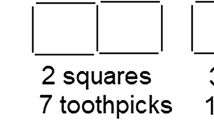Abstract
This paper deals with a teaching approach aimed to help students become aware of targeted techniques of significance in problem solving. The teaching approach is to present a series of tasks that all can be solved by applying the same technique. Two levels of prompting are used; first for the students to realize solutions without necessarily being cognizant of the technique, second for them to perform further mathematical modeling that should highlight the similarities in solution shared by all the tasks. In the fieldwork, a teaching sequence based on this approach is implemented for a technique involving enumeration via constructing a bijection. Certain factors in the students' behavior suggested that their realization of the technique at the end was not as secure as desired. Some modifications of the teaching sequence are proposed to counter these factors.
Similar content being viewed by others
REFERENCES
Arzarello, F., Bartolini Bussi, M. and Robutti, O.: 2002, 'Time(s) in the didactics of math-ematics: a methodological challenge', in L.D. English (ed.), Handbook of International Research in Mathematics Education, Lawrence Erlbaum, Hillsdale, NJ, pp. 525–552.
Carlson, M.P.: 1998, 'A cross-sectional investigation of the development of the function concept', Conference Board of the Mathematical Sciences Issues in Mathematical Edu-cation 7, 114–162.
Chevallard, Y.: 1999, 'L'Analyse des Pratiques Enseignantes en Thorie Anthropologique du Didactique', Recherches en Didactique des Mathmatiques 19(2), 221–266.
Dorier, J.L.: 1995, 'Meta level in the teaching of unifying and generalizing concepts in mathematics', Educational Studies of Mathematics 29, 175–197.
Fischbein, E. and Grossman, A.: 1997, 'Tacit mechanisms of combinatorial intuitions', Proceedings of the 21st Conference of the International Group for the Psychology of Mathematics Education, Vol. 2, Lahti, Finland, pp. 265–272.
Giles, E.J. and Gilbert, J.K.: 1981, 'Prompting in one-to-one problem solving situations', International Journal of Mathematical Education in Science and Technology 12(1), 125–133.
Greer, B. and Harel, G.: 1998, 'The role of isomorphisms in mathematical cognition', Journal of Mathematical Behaviour, 17(1), 5–24.
Jones, D. and Bush, W.S.: 1996, 'Mathematical structures: answering the "why" questions', The Mathematics Teacher 89(9), 716–722.
Kieran, C. and Dreyfus, T.: 1998, 'Collaborative versus individual problem solving: entering another's universe of thought', in A. Olivier and K. Newstead (eds.), Proceedings of the 22nd International Conference for the Psychology of Mathematics Education,Vol. 3, Stellenbosch, South Africa, pp. 112–119.
Linn, M.C. and Kessel, C.: 1996, 'Success in mathematics: increasing talent and gender diversity among college majors', Conference Board of the Mathematical Sciences Issues in Mathematics Education 7, 101–144.
Mason, J.: 2000, 'Asking mathematical questions mathematically', International Journal of Mathematical Education in Science and Technology 31(1), 97–111.
Polya, G.: 1957, How to solve it, Princeton University Press, Princeton.
Rickart, Ch.: 1996, 'Structuralism and mathematical thinking', in R.J. Sternberg and T. Ben–Zeev (eds.), The Nature of Mathematical Thinking, Lawrence Erlbaum, Mahwah, NJ, pp. 285–300.
Robert, A. and Robinet J.: 1996, 'Prise en compte du mta en didactique des mathmatiques', Recherches en Didactique des Mathmatiques 16(2), 145–176.
Schoenfeld, A.H.: 1985, Mathematical Problem Solving, Academic Press, Orlando, FL.
Schoenfeld, A.H.: 1992, 'Learning to think mathematically: problem solving, metacognition, and sense making in mathematics', in D. Grouws (ed.), Handbook of Research on Mathematics Teaching and Learning, Macmillan and National Council of Teachers of Mathematics, New York, pp. 334–370.
Selden, A., Selden, J., Hauk, S. and Mason, A.: 2000, 'Why can't calculus students access their knowledge to solve non-routine problems?', Conference Board of the Mathematical Sciences Issues in Mathematics Education 8, 128–153.
Speiser, B.: 1997, 'Block towers and binomials', Journal of Mathematical Behavior 16(2), 113–124.
Thompson, P.W.: 1994, 'Students, functions, and the undergraduate curriculum', Conference Board of the Mathematical Sciences Issues in Mathematics Education 4, 21–44.
Weber, K.: 2002, 'Student difficulty in constructing proofs: the need for strategic knowledge', Educational Studies in Mathematics 48(1), 101–119.
Author information
Authors and Affiliations
Rights and permissions
About this article
Cite this article
Mamona-Downs, J., Downs, M. Realization of Techniques in Problem Solving: The Construction of Bijections for Enumeration Tasks. Educational Studies in Mathematics 56, 235–253 (2004). https://doi.org/10.1023/B:EDUC.0000040414.92348.08
Issue Date:
DOI: https://doi.org/10.1023/B:EDUC.0000040414.92348.08




